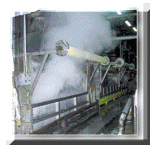|
space
dyed carpet
Space Dyed Carpet

Space
dyed carpet is a yarn dyeing process in
which different colors are applied along a length of yarn (usually a
continuous filament strand) at intervals. Space dyed yarn produces, in
its subsequent tufted fabric form, an effect of random, unorganized
design.
Methods Of Space Dyeing
Knit de knit (KDK) - A printing
process in which filament yarn is knitted into a plain circular tube, or
"sock," and printed with short sections of color in a
multicolored pattern. The printed knit tube is then steamed, washed,
extracted, and dried, after which it is "de-knitted." The
unraveled printed yarn is rewound onto cones and may be plied or
entangled with other yarns (depending on the desired visual effect)
before tufting takes place.
In this process, the knitted tube is usually dependable and trouble free, requiring a
minimum of attention and technology if the supply yarn is uniform and contains few knots or
splices.
Numerous size variations are possible, but a three-inch diameter circular knitted unit is
the most commonly used.
Some space dyers using a flat bed machine can make up to a 25" flat knit tube to be
used in the space dyeing process.
Although the basic coloration techniques are the same, various types of printing heads are
used, the most common being the engraved roller printer. Normally a base color is
applied by a pad dyeing technique in which the knitted tube is
completely covered in a solid dye or print bath, then forced through a
press roller to give a residual 90-100% takeup of pad dye liquor. This
step is immediately followed by a wet-on-wet overprinting in which
stripe patterns of several other colors are applied with a series of en
raved rollers.
Achieving a successful overprinted pattern is quite a complicated process, requiring
careful color matching and considerable expertise. But once a good pattern is developed, it
usually enjoys a long production life.
To fix the printed color onto the yarn, the knitted tubing is steamed for six to 12
minutes at 220 to 230 degrees F. It then goes through a series of wash boxes and/or
pressure sprays to remove excess color. An anti-stat finish is usually added at
this point, to assist in the subsequent de-knitting and tufting process.
In the final step of the dyeing process, the tubing is dried, with the
choice of dryer being determined by the type of product for which the yarn
will be used.
The knitted yarn is unraveled with great care (pulling the wrong yarn end, for example,
causes serious processing difficulties later) and wound onto cones to be shipped to the
tufting or weaving mill.
The tufted pattern achieved with KDK yarns is unique and cannot be obtained through any
other dyeing process. In low pile, low-weight carpets especially contract types - the
mottled multicolor effect hides soil, adds visual interest, and blends with
almost any type of decor. Other advantages specific to the KDK process
are color flexibility (a number of colors can be applied to a single
strand of yarn), good color uniformity, and large dye lot capability.
Disadvantages of the knit-deknit system are as follows: - There is a characteristic curl to
the yarn caused by its having been in a knitted tube; the curl becomes apparent when cut
pile styles are produced from this yarn.
- The printing is not precise and
clean, due to its being done over a loop of yarn rather than a flat yarn
end.
- It is difficult to process staple
spun yarn by this process because of its hairy qualities, which
cause particular problems during de-knitting.
Warp Printing - A printing
process in which dye is applied to parallel strands of yarn before they
are tufted. First, cones of natural yarn are placed in a creel, or
feeder apparatus. The yarn is then warped, which is the operation of
aligning individual yarn strands in parallel position in preparation for
the next processing step - either tufting or dyeing. In this case, the
taut strands of yarn are printed with dye, creating long expanses of
color along them. Next, the dyed yarn is steamed to set the color, after
which it is washed several times. In a final bath, finish and antistat
are applied, and the yarn is dried. The yarn is collected on beams and
then rewound onto individual cone packages. This final stage is
critical, since it requires total tension control and maximum caution to
prevent a broken end from tangling the entire beam. At this point, the
finished yarn is ready for tufting.
This type of warp printing
system has several advantages:
-
Producing a yarn with
no distortion, such as curl or crimp
-
Ability to program a
sequence of colors of varying lengths along the yarn
-
Printing of a flat yarn
segment
Major disadvantages of warp printing
are:
- Yarn ends may break or tangle,
becoming difficult to handle, and the heated metal cans used to dry
the yarn can flatten it and reduce its bulk.
Overall, warp printing gives very good
color control compared to other space dye methods, and it has been a
successful, important coloration technique. The printed yarns, with
their long expanses of color, create free-form tufted patterns that are
extremely popular in today's carpet market.
See Also:
continuous dyeing |
beck dyeing |
skein dyeing |
solution
dyeing
©2010 FloorBiz, Inc. All Rights Reserved
Flooring |
Flooring Guide |
Flooring Info |
Flooring Forum
| |
